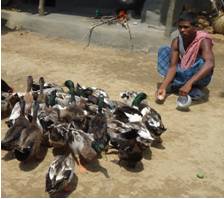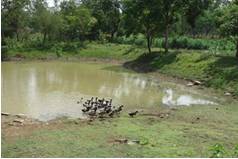 Bhatunia Keonjhar district, Odisha is an adopted village under NAIP project “Sustainable livelihood improvement through aquaculture, horticulture and livestock development in Keonjhar, Mayurbhanj and Sambalpur districts of Orissa”. More than 80 percent of the population is scheduled caste or tribe. Sri Sunakara Dehury is a BPL farmer of the area with 1.2 acres of agricultural land, 0.3 acres of seasonal pond besides a small dwelling mud house of his own. The whole family depends on the single crop of rice and some earning as daily labour. The maximum family income never goes beyond rupees 25,000/- per annum.
Bhatunia Keonjhar district, Odisha is an adopted village under NAIP project “Sustainable livelihood improvement through aquaculture, horticulture and livestock development in Keonjhar, Mayurbhanj and Sambalpur districts of Orissa”. More than 80 percent of the population is scheduled caste or tribe. Sri Sunakara Dehury is a BPL farmer of the area with 1.2 acres of agricultural land, 0.3 acres of seasonal pond besides a small dwelling mud house of his own. The whole family depends on the single crop of rice and some earning as daily labour. The maximum family income never goes beyond rupees 25,000/- per annum.
Regional Centre, Central Avian Research Institute, Bhubaneswar as a consortia partner, motivated Sri Dehury to utilize his small unproductive pond for duck rearing. Brief on- farm training was given to him along with other beneficiaries regarding brooding of day old ducklings, feeding and other management practices. Sri Dehury was given 35 one- day old ducklings (Native cross variety), 10 kg of initial feed, one feeder and one drinker to initiate the unit during the month of June 2011. The family members constructed a small house (12ft X 6ft) with bamboo and mud by the side of their own living house. During first 10 days the ducklings were offered soaked feed and sufficient clean drinking water twice daily. Rice husk used as litter material was changed twice during brooding period. Soaked or boiled rice was also offered to the birds. On 25th day, ducklings were allowed to enter the pond. The ducks were kept in the pond during day and kept inside the house during night. By one month, 31 ducklings were found alive with an average body weight of 411.65 + 26.33g . By the end of 3 months they were able to distinguish male ( 14) and female (17 ) ducks.
 From 6th month onward, the family members collected at least 9 eggs daily. As per the advice, Sri Dehury collected fish scales from the nearest fish market regularly and offered to the birds. During laying period, Liquid calcium preparation (Calmore) were fed to the birds in alternate day (20ml) along with the kitchen wastes. During peak of winter once the birds showed dullness for 2-3 days during which Tetracyclin powder (3g) mixed in water was drenched for 3 consecutive days and birds were found active and alright.
From 6th month onward, the family members collected at least 9 eggs daily. As per the advice, Sri Dehury collected fish scales from the nearest fish market regularly and offered to the birds. During laying period, Liquid calcium preparation (Calmore) were fed to the birds in alternate day (20ml) along with the kitchen wastes. During peak of winter once the birds showed dullness for 2-3 days during which Tetracyclin powder (3g) mixed in water was drenched for 3 consecutive days and birds were found active and alright.
After eight months of laying it was found that total number of eggs collected was 2642 out of which more than 2100 eggs were sold in local market (@ 5/- each). The total earning from duck rearing during this period was Rs 14,400/- including the sale of male birds.
Besides Sri Dehury, at least 450 such farmers and 30 SHGs of this project in three tribal districts of Odisha are rearing duck either in their own ponds or in community ponds since last one and half year which aids significantly to the livelihood of these farm families for a sustainable agriculture.
(Source: Dr S.C.Giri, Senior Scientist and CCPI, NAIP, Regional Centre, CARI, Bhubaneswar.)







फेसबुक पर लाइक करें
यूट्यूब पर सदस्यता लें
X पर फॉलो करना X
इंस्टाग्राम पर लाइक करें